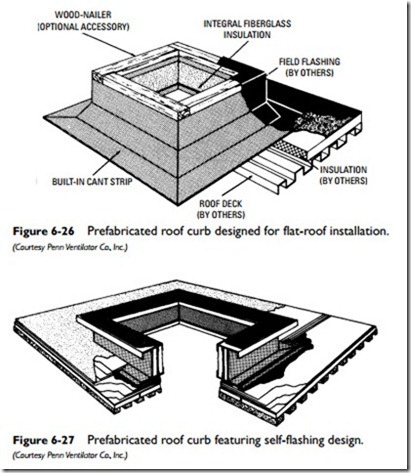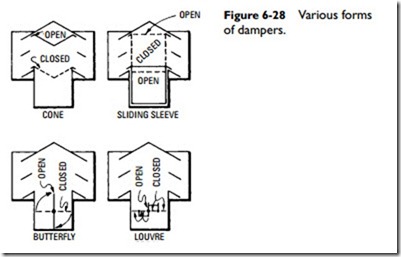Prefabricated Roof Curbs
Prefabricated roof curbs (bases) for ventilators are available from a number of manufacturers. One of the advantages of the prefabricated type over those constructed at the site is the fact that they are generally cheaper. This, of course, is due to their being mass- produced. Although commonly designed for flat-roof installation, prefabricated roof curbs can also be built for installation on the ridge or single slope of a roof. Figures 6-26 and 6-27 illustrate some of the design features incorporated in a prefabricated roof curb.
Ventilator Dampers
Ventilator dampers (see Figure 6-28) are made in a variety of types, from the single-disc butterfly to the multiblade louver, which has been designed to allow a flexible and reliable means of air movement control. A tight seal can be obtained through the use of a damper ring, which prevents the passage of air when the damper is closed.
Some dampers can be controlled only by hand chain; others may be remotely operated through the use of damper control motors of the electric or compressed-air type.
The principal types of ventilator dampers are as follows:
1. Sliding sleeve
2. Fire-retarding cone
3. Single butterfly
4. Divided butterfly
5. Louver
Louver Dampers
Figure 6-28 shows the general appearance of a louver damper. It is considered the best type for airflow. Louver dampers offer little resistance to the passage of air and in a partially open position create little turbulence in the airstream. In multiblade louvers, the blades on one half open up, and those on the other half open down.
The center blade is double the width, and its edges are connected to adjacent blades by clips and bars. The spacing of the blades along the connecting bars has been closely studied to ensure that the blade edges seat tightly on the damper ring when closed. This damper ring also allows all the blade pivot bearings to be placed inside the ventilator shaft, away from the weather. It also eliminates holes through the airshaft that might leak air and rain. Blades are regularly weighted so that the damper closes automatically. Any type of control may be used.

